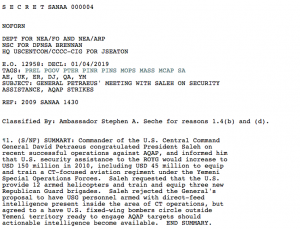“At the Highest Levels of the U.S. Government” … Like the President?
Update: Obama did, in fact, take responsibility for ordering the killing.
And as President, I would have been derelict in my duty had I not authorized the strike that took out Awlaki.
There’s something missing from Eric Holder’s 8 paragraphs justifying the assassination of Anwar al-Awlaki.
In spite of the many sanctioned leaks asserting that President Obama “insist[s] on approving every new name on an expanding ‘kill list,'” Holder never explicitly says Obama did so with Awlaki. The Attorney General attributes the decision itself to “high-level U.S. government officials,” “senior officials,” and “senior officials” again.
Here’s how he describes the review process:
The decision to use lethal force is one of the gravest that our government, at every level, can face. The operation to target Anwar al-Aulaqi was thus subjected to an exceptionally rigorous interagency legal review: not only did I and other Department of Justice lawyers conclude after a thorough and searching review that the operation was lawful, but so too did other departments and agencies within the U.S. government.
The decision to target Anwar al-Aulaqi was additionally subjected to extensive policy review at the highest level of the U.S. Government, and senior U.S. officials also briefed the appropriate committees of Congress on the possibility of using lethal force against al-Aulaqi. Indeed, the Administration informed the relevant congressional oversight committees that it had approved the use of lethal force against al-Aulaqi in February 2010 — well over a year before the operation in question — and the legal justification was subsequently explained in detail to those committees, well before action was taken against Aulaqi. This extensive outreach is consistent with the Administration’s strong and continuing commitment to congressional oversight of our counterterrorism operations — oversight which ensures, as the President stated during his State of the Union address, that our actions are “consistent with our laws and systems of checks and balances.”
Sure, the code words meaning “the President” are in there: “at every level,” “at the highest level of the U.S. Government.” It quotes Obama’s State of the Union address at the very end, like a flourish detached from the nasty killing bit.
And the process described here, where “the Administration” informs the intelligence committees of the lethal force operations “it had approved,” is clearly that of a covert op, which requires the President’s to inform Congress of covert ops he has approved.
But unlike DOJ and the congressional committees, he’s not named in the decision process that ended up killing Awlaki. (Though Holder does later say that Obama approved the Disposition Matrix which he describes will soon be briefed to Congress, which of course implies Presidential approval for all the drone deaths to come, but not Awlaki’s.)
This might be a picayune observation if this Administration had not, secretly, made almost unprecedented efforts to keep a short phrase indicating the President (Bush) had authorized the torture program.
In his letter, Holder references Obama’s Archives Speech pledge that “whenever possible, my administration will make all information available to the American people so that they can make informed judgments and hold us accountable” (though in Holder’s letter, the “us” becomes “their Government”). He ends this letter by assuring its recipients “that the President and his national security team are mindful of this Administration’s pledge to public accountability for our counterterrorism efforts.”
But on the specific issue of Anwar al-Awlaki’s killing, this letter allows Obama (along with the CIA and DOD, presumably to avoid helping the ACLU in its FOIA — though it may be too late) to avoid any accountability.
Perhaps tomorrow Obama will stand before a bunch of cameras and admit “I personally ordered an American citizen to be drone killed.” But this letter feels like an effort to help him avoid publicly accepting just that responsibility.
Update: As QuietAmerican reminded me, Obama is quoted in that NYT piece as saying the decision to kill Awlaki was “an easy one.”


